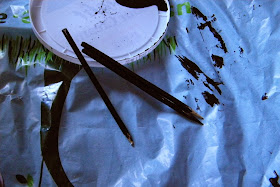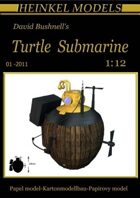The Turtle Submarine was invented by David Bushnell to be used during the American Revolution to attach bombs underneath enemy ships. Daniel first heard about this from the series, Liberty Kids. He decided he wanted to research a little and ultimately did his history "share" project on The Turtle.
Display boards are nice, but Daniel wanted to make a model of the submarine. We purchased a paper model .pdf, but it was too difficult. So, we decided to come up with our own. I helped Daniel design this model based upon the picture below of the paper model we bought, but he did the majority of the work of putting it together.
Here's how we did it:
Supplies:
1 2 liter bottle
2 empty ribbon spools
Masking tape
Acrylic paint- black, yellow, brown
Construction paper- blue, yellow and black
Sharpie
3 pieces of a skewer painted black
black and gold pipe cleaners
2 cream colored beads
1 small square jewelry box
Procedure:
First, we took a 2 liter bottle and cut out a large portion of the middle. Using masking tape, we taped the 2 halves together into what looked like an oval acorn shape. On top of the bottle half of the 2 liter bottle, we taped an empty cardboard ribbon spool. Then, we covered the entire surface of the bottle with masking tape. The actual Turtle submarine had vertical wooden planking spanning most of it's body. So, we made sure that the masking tape was placed to mimic that effect.
Painting was next. Daniel painted the top portion yellow with a small band of black underneath.
Then, he painted and prepped the accessories that would be attached to the surface of the submarine.
An empty jewelry box painted black that will be adhered to the back with double-sided tape.

Air tubes made from gold pipe cleaners with beads on the end to be inserted in the top of the ribbon spool. We poked 2 holes in the top with a screwdriver and inserted them.
Our three dowel rods painted black will be inserted into the top and side. Black pipe cleaners will be used to fashion propellers, connection wires and other submarine-y type apparatuses. We had to be very careful poking the holes into the sides and top. Daddy helped with this part.

The bottom 2/3rds Daniel painted brown. When it dried he went back and added black lines to mimic the wooden panels and dots for rivets.

Blue and yellow construction paper were cut and glued together to resemble the 5 port holes. Then glued to the top of the model.
Since the top of the 2 liter bottle is actually the bottom of the model, we needed a stand. Daniel painted a taller cardboard ribbon spool brown and it made a perfect stand for his model.
The finished product:
For more information about David Bushnell's Turtle Submarine:
Turtle (submersible)
The Submarine Turtle: Naval Documents from the Revolutionary War
Books:
American Turtle Submarine The Best Kept Secret of the American Revolution
Attack of the Turtle



















































